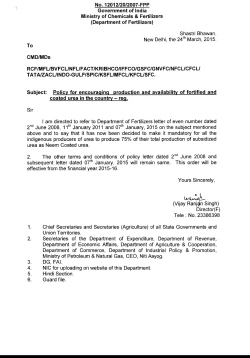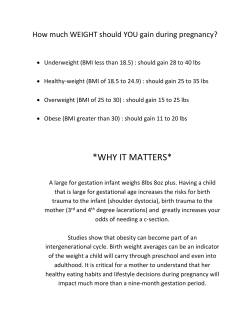
Pop-Up & Starter Fertilizers in Corn & Soybeans
Cornell University Cooperative Extension Northwest New York Dairy, Livestock & Field Crops Team Pop-Up & Starter Fertilizers in Corn & Soybeans By Bill Verbeten, Regional Agronomist, Cornell Cooperative Extension In NWNY, farmers are moving away from broadcasting fertilizers in an attempt to increase corn & soybean yields, increase earlier season growth to better compete with weeds, insects, & disease, and possibly shorten days to maturity by maximizing the fertilizer placed with the seed as pop-up and starter fertilizers. Too much fertilizer will cause damage to the seeds because of salt competing with the seed for moisture. Too little fertilizer will not show a response compared to broadcasting. Yield responses to these fertilizer placement methods are very dependent on soil test levels, tillage systems, and weather. This article discusses the maximum amounts of fertilizer that can be applied in pop-up and starter fertilizers. Many situations on-farm will require LESS FERTILIZER than what is discussed here. Regular soil and tissue testing are necessary to determine what the specific crops needs are for each field. Pop-Up Fertilizers Fertilizer salts compete with corn and soybeans seedlings for water when placed as a pop-up. Maximum applications for pop-up fertilizers are listed in Table 1. Nitrogen and potassium (K2O) fertilizers are the strongest salts, and their combined application amounts need to remain small to avoid salt injury. Dry conditions and sandy soils are more likely to have salt damage to seeds than wet conditions and clay soils. Reduce the nitrogen + K2O rates in Table 1 by half if growing corn and soybeans on sandy soils or if there is below normal rainfall at the time of planting. Additionally no urea, UAN, or ammonium thiosulfate should be used as a pop-up. Phosphorus (P2O5) fertilizers have a lower salt index on average (18.8) than nitrogen (78.3), potassium (58.0), and sulfur (50.5), p. 381 Soil Fertility & Fertilizers 7th Ed., Table 1: Pop-Up Fertilizer Application Limits Nutrient Nitrogen + K2O * P2O5 * Corn (30 inch rows) 10 30 Maximum Amount to Apply (lbs./acre) Soybean** Soybean** (15-20 inch (30 inch rows) rows) 0 5 20 20 Soybean** (7-8 inch rows) 10 20 *P2O5 and K2O are how phosphorous and potassium fertilizers are analyzed and recommendations made based on soil tests. 1 lbs. of P2O5 = 0.44 lbs. actual phosphorous, 1 lbs. of K2O = 0.83 lbs. actual potassium. Source: South Dakota State University ** Cornell & Penn State recommendations discourage any pop-up fertilizers on soybeans. fertilizers. Salt index is a measure of how strongly the fertilizer will affect moisture available to the crop (higher number = more drying effect). Ammonium sulfate (24% S), gypsum (18% S), or potassium sulfate (17% S) should be used for popup sulfur applications. Elemental sulfur will not be immediately available for crop needs and should not be used in a pop -up or starter. Cornell Cooperative Extension provides equal program and employment opportunities. Cornell University Cooperative Extension Northwest New York Dairy, Livestock & Field Crops Team Pop-Up & Starter Fertilizers in Corn & Soybeans By Bill Verbeten, Regional Agronomist, Cornell Cooperative Extension Starter Fertilizers Table 2: Starter Fertilizer Application Limits Placing the fertilizer 2 inches below and 2 inches Maximum Amount to Apply (lbs./acre) to the side of the seed greatly increases the Corn Soybean amount of fertilizer that can be applied to corn Nutrient (30 inch rows) (30 inch rows) and soybeans compared to a pop-up, Table 2. Nitrogen + K2O 80-100 60 Drilled soybeans should have fertilizer 50 20 broadcasted as it is nearly impossible to band a Nitrogen starter with most currently available drills, unless P2O5* 70 50 a liquid fertilizer retrofit is installed. The amount K2O* 50 40 of phosphorous in a starter is generally limited Sulfur** 15 15 by the nitrogen also in the fertilizer. Do not apply Zinc 2 2 more than 30 lbs./acre P2O5 as DAP, 30lbs./acre nitrogen as urea, or a combination of these two *Fertilizer recommendations are lower for higher testing soils. to avoid seeding injury. Exceeding the Source: 2014 Cornell Field Crop Guide recommended limits of P2O5 in the starter can ** University of Minnesota cause zinc deficiency. Zinc can also be applied in a starter if soil tests are low, but yield responses generally do not occur above applying 0.5-1.0 lbs./acre of actual Zn, although 2 lbs./acre can be applied to build up soil levels if needed. Sulfur can be also applied as a starter and total application should not exceed 25 lbs./acre as there is usually not a yield response above this level. If more than 80 lbs./ acre of N + K2O (20-25 ga./acre of liquid nitrogen fertilizers at 30-35% N) is applied increase the starter distance from 2 x 2 inches to 3 X 3 inches or more from the seed. Avoid putting anhydrous ammonia near the seeds. Effects of Tillage Systems and Soil Test Levels Responses to pop-up and starter fertilizer are very dependent on tillage systems and soil test levels. The yield response to phosphorus fertilizers is generally determined by soil test level and not tillage system or application method. Despite having little effect on yields, vigorous early season growth of corn and soybeans have been observed when using phosphorus pop-ups and starters compared to broadcast applications. However there is often a yield response to potassium fertilizers when applied as pop-ups, starters, and deep banding (>6 inches) especially in zone and strip till systems compared to no-till or mulch till systems. Nitrogen applications should be maximized in the pop-ups and starters as nitrogen losses are greatly decreased when placed in the soil, especially for reduced tillage situations. In sandy soils total sulfur applications should be 15-25 lbs./acre across all tillage systems based on soil tests. Loam and clay soils are more responsive to sulfur applications of 15-25 lbs./acre when using no-till, strip-till, and zone-till systems compared to conventional tillage, even when soil sulfur tests are in the high range. Responses to micro-nutrients are more likely on sandy soils, muck soils, in dry years, in soils with extreme pH levels, low organic matter soils, and soils that have not had manure applications. Use soil tests or tissue tests to determine if a response is likely. Additional fertilizer is often needed beyond pop-ups and starters to reach yield goals and should be applied by side-dressing, broadcasting, and/or applying small amounts as foliar solutions. Cornell Cooperative Extension provides equal program and employment opportunities.
© Copyright 2025









